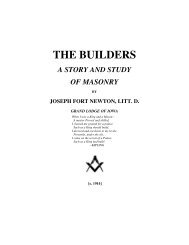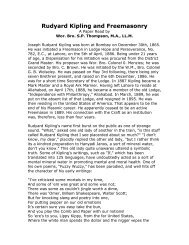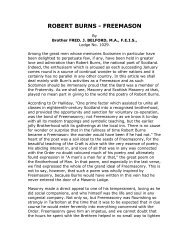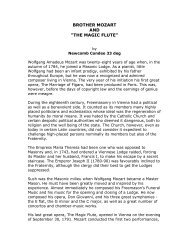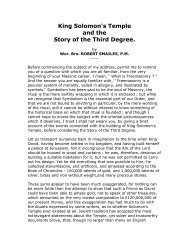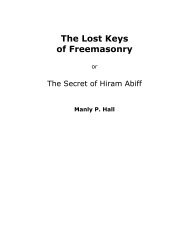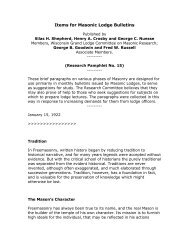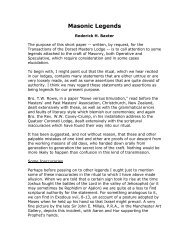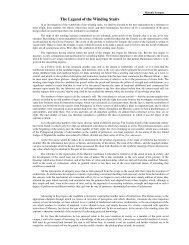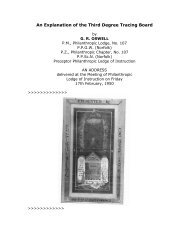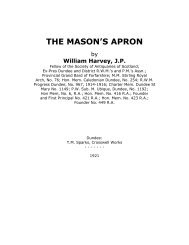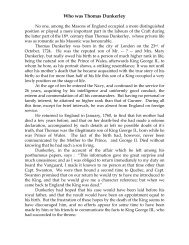Through the Key Hole - RoseCroix.org.au
Through the Key Hole - RoseCroix.org.au
Through the Key Hole - RoseCroix.org.au
Create successful ePaper yourself
Turn your PDF publications into a flip-book with our unique Google optimized e-Paper software.
61<br />
A FICTITIOUS GRAND LODGE?<br />
By Keith Stockley<br />
In his Constitutions of 1738, Dr Anderson states that a General<br />
Assembly of <strong>the</strong> Craft was held on 27 December 1663 at <strong>the</strong><br />
instance of Henry Jermyn , <strong>the</strong> Earl of St Albans, who in his purported<br />
position as Grand Master of English Freemasons appointed<br />
as his deputy, Sir John Denham and his Wardens, Sir<br />
Christopher Wren and John Webb and <strong>the</strong>n promulgated Rules<br />
known as <strong>the</strong> Regulations of 1663.<br />
The Regulations referred to by Anderson are those contained in<br />
<strong>the</strong> Harleian Ms. No. 1942 as well as a few o<strong>the</strong>r Mss and are<br />
now called <strong>the</strong> New Articles which have been dated around<br />
1670.<br />
Did such an assembly meet as stated by Anderson? It is certain<br />
that no such Grand Lodge existed at that time, so was <strong>the</strong> assembly<br />
and <strong>the</strong> appointment of <strong>the</strong> personages named merely a<br />
work of fiction dreamt up by Anderson?<br />
MALCOLM CANMORE DUNCAN<br />
By Keith Stockley<br />
Duncan’s Ritual & Monitor of Freemasonry is perhaps <strong>the</strong> most<br />
widely read book on Masonic ritual, in <strong>the</strong> USA. Yet <strong>the</strong> <strong>au</strong>thor<br />
Malcolm Canmore Duncan is totally unknown.<br />
Thorough research has been undertaken to try and establish <strong>the</strong><br />
identity of <strong>the</strong> bro<strong>the</strong>r who clearly had considerable and significant<br />
knowledge of <strong>the</strong> Craft, as his book is in great detail and is<br />
amazingly accurate in respect of <strong>the</strong> EAF, FC , MM , PM, Most<br />
Excellent Master and <strong>the</strong> RA.<br />
Such knowledge can only come from a Freemason of many<br />
years standing and experience.<br />
The name of <strong>the</strong> <strong>au</strong>thor is I feel, more symbolic than factual. In<br />
o<strong>the</strong>r words it is a nom de plume for <strong>the</strong> <strong>au</strong>thor’s real name.<br />
114<br />
SIR CHRISTOPHER WREN AND<br />
FREEMASONRY– NEW EVIDENCE<br />
Br Bro. Bernard Williamson & Bro. Michael Baigent<br />
A search through <strong>the</strong> archives of <strong>the</strong> Royal Society has provided new<br />
information regarding <strong>the</strong> claim that Sir Christopher Wren was initiated<br />
into Freemasonry in London on 18 May 1691. This claim was advanced<br />
in a handwritten note added to <strong>the</strong> manuscript of John Aubrey;’s<br />
“Naturall Historie of Wiltshire in 16185, now in <strong>the</strong> Bodleian<br />
Library, Oxford.<br />
This manuscript is in two parts, bound and filed separately as MS Aubrey<br />
1 and MS Aubrey 2. In <strong>the</strong> second part a short account of Freemasonry<br />
appears:<br />
“Sr. William Dugdale told me many years since, that about Henry <strong>the</strong><br />
third’s time, <strong>the</strong> Pope gave a Bull, or Diploma to a company of Italian<br />
Architects to travell up and down over Europe, to build churches. From<br />
those are derived <strong>the</strong> Fraternity of Free-Masons. They are known to<br />
one ano<strong>the</strong>r by certain Signes and ( ‘Markes’<br />
Erased) and Watchwords; it continues to this day. They have severall<br />
lodges in severall Counties for <strong>the</strong>ir reception; and when any of <strong>the</strong>m<br />
fall into decay, <strong>the</strong> bro<strong>the</strong>rhood is to relieve him & c. The manner of<br />
<strong>the</strong>ir Adoption is very formall and with an Oath of secrecy.”<br />
The page to <strong>the</strong> left of this account was originally left blank and on<br />
this, at some later time, were added three additional notes in Aubrey’s<br />
hand. One of <strong>the</strong>se notes concerns Freemasonry. It reads”<br />
MDM, this day (May 1691 <strong>the</strong> 18th being Monday after Rogation Sunday)<br />
is a great convention at St. P<strong>au</strong>l’s—church of <strong>the</strong> fraternity of <strong>the</strong><br />
Accepted (‘Free’ being struck out) Masons where Sr.<br />
Christopher Wren is to be adopted a Bro<strong>the</strong>r ; and Sr. Henry Goodric…..of<br />
ye Tower, & divers ( ‘Sev’al’ being struck out) o<strong>the</strong>rs—<strong>the</strong>re<br />
have been Kings, that have been of this—Sodalite.”<br />
Of those who have studied <strong>the</strong> text, Clarke in Ars Quatuor Coronatorum<br />
1965 concluded that Wren was ‘almost certainly’ a Freemason.<br />
John Hamill in 1986 in his book “The Craft” is more c<strong>au</strong>tious, concluding<br />
that mo matter how possible it might be, Wren’s membership was<br />
‘not proven’.



